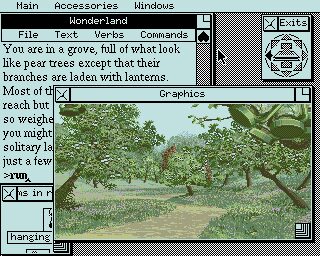
Author: Tasha - Published: 27 October 2017, 8:44 pm
Wonderland is a text adventure developed by Magnetic Scrolls and published by Virgin Mastertronic in 1990 for DOS. It was ported to the Amiga, Atari ST, and Acorn 32-Bit the following year. The story and visuals of the game are based on the Lewis Carroll novel Alice in Wonderland.
The game was written by David Bishop, who also worked on famous titles such as The Lion King and Disney's Aladdin. You will take your own trip into Wonderland by stepping into the iconic Alice's shoes. Though the game's storyline follows the basic framework of the novel, the developers put their spin on many things throughout the world to change it up.
Read More
Author: Tasha - Published: 26 October 2017, 1:58 am
Darkmere (or Darkmere: The Nightmare’s Begun) is a fantasy RPG-action-adventure game developed by Zero Hour Software. It was published by Core Design in 1994 for the Amiga. There was also an intended Atari version of the game that fell through.
The game was designed by Mark K. Jones, who also created its fantastic graphics. Stepping into the shoes of Prince Ebryn, you are sent on a quest by your father, the king, who has allowed the kingdom to fall to ruin. Reaching a new low, a dark cloud covers the land, and it’s up to you to bring it back from the brink. You must discover the source of the evil darkness before heading out into a hostile world, equipped only with your elven sword. Ebryn can walk around in 4 directions and examine things. He can also question friendly NPCs about different things to gain what information they may have. Combat happens in real-time with enemies seen walking around the game world rather than randomly appearing. Take on and complete quests to progress through the story and help Ebryn reclaim his kingdom.
Read More
Author: Tasha - Published: 22 October 2017, 12:26 am
Monty on the Run is the third game in the Monty Mole series, developed and published by Gremlin Graphics Software in 1985.
Wanted! Monty Mole, created by Peter Harrap, was a popular video game series in the '80s. The game was inspired by the British Miners' Strikes that happened in 1984-85. Developed initially for the ZX Spectrum, it was ported to the Commodore 64. The second game (Monty Is Innocent) was only released for the ZX Spectrum. This third game, probably the most successful, in addition to C64 and ZX Spectrum, was ported to several platforms, including Amstrad CPC, Commodore 16, and Plus/4. The Commodore 64 version features a fantastic soundtrack composed by Rob Hubbard, probably one of the best 8-bit soundtracks ever.
Read More
Author: GN Team - Published: 16 October 2017, 9:51 pm
Crazy Cars III (re-released later as Lamborghini: American Challenge) is the third entry in the Crazy Cars series. It was developed and published by Titus France in 1992 for the Amiga, DOS, Atari, and others. It was further ported in the subsequent years following its release.
If you like Lamborghinis and/or illegal street racing, you’re in the right place. Starting with a low-mod vehicle and $6k in your pocket, you aim to reach the top of the racing circuit. Racing on roadways scattered all over the United States, take on 60 races against opponents and take home the title. Aside from racing itself, you can earn funds by betting on the outcome of the races and other drivers. Use those funds to upgrade your car and stay ahead of the competition. There are many civilian drivers to watch out for, as well as police officers looking to run your speeding ass off the road.
Read More
Author: GN Team - Published: 14 October 2017, 3:42 pm
Pitfall II: Lost Caverns is the sequel to David Crane's award-winning Pitfall. It was developed and published by Activision in 1984. It was released for nine platforms, including Apple II, Commodore 64, Colecovision, and Atari 5200. The following year, it was ported to a few more platforms, including an arcade version by Sega.
Pitfall Harry is at it again and is on the hunt for the Raj Diamond. Making his way through the Andes, he will face many dangers along the way. This sequel is a side-scrolling platformer and plays like the first Pitfall!. The levels are a little more complex than before; there are many paths to explore and treasures to find. Harry can also tick checkpoints to start from should he die. Harry now has unlimited lives, making the game a little less frustrating. Lost Caverns introduces two new faces (NPCs) into the story and features a soundtrack for the first time (an impressive feat for an Atari 2600 game).
Read More
Author: Tasha - Published: 10 October 2017, 8:43 pm
Wizardry: Crusaders of the Dark Savant is the seventh chapter in the fantasy RPG series Wizardry. It was developed and published by Sir-Tech in 1992 for MS-DOS. In 1996, a remake was published under the title Wizardry Gold for Windows and Macintosh. If you want this Gold version, follow the link below.
The story ties directly to the previous installment, Wizardry: Bane of the Cosmic Forge. Picking up where that story left off, you are now chasing after the creatures that stole the Cosmic Forge from your grasp. Certain things in the story differ depending on your choices in the previous game, such as whether you should choose to import your party. In keeping with the earlier games, Crusaders of the Dark Savant retains the races, classes, turn-based combat, and magic schools. There are also familiar skills, as well as a few new ones.
Read More